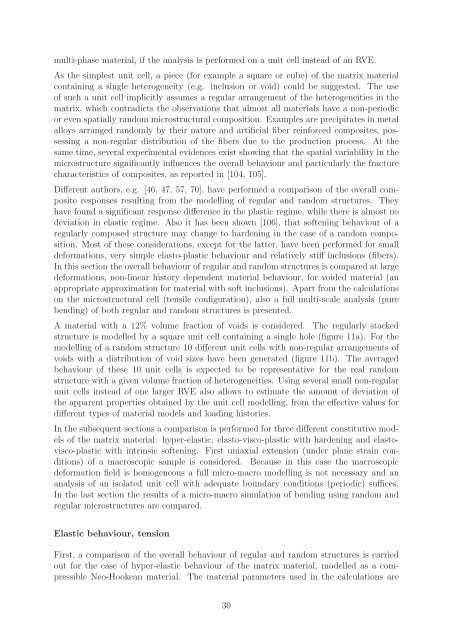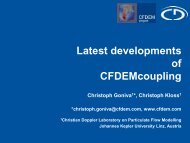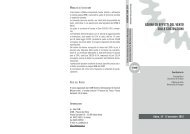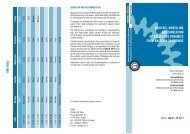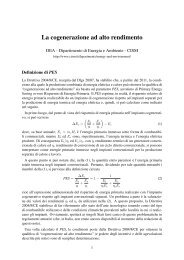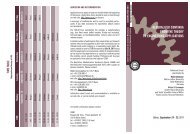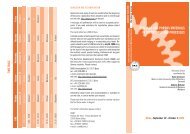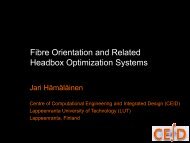Scale transitions in solid mechanics based on computational ... - Cism
Scale transitions in solid mechanics based on computational ... - Cism
Scale transitions in solid mechanics based on computational ... - Cism
- No tags were found...
You also want an ePaper? Increase the reach of your titles
YUMPU automatically turns print PDFs into web optimized ePapers that Google loves.
multi-phase material, if the analysis is performed <strong>on</strong> a unit cell <str<strong>on</strong>g>in</str<strong>on</strong>g>stead of an RVE.As the simplest unit cell, a piece (for example a square or cube) of the matrix materialc<strong>on</strong>ta<str<strong>on</strong>g>in</str<strong>on</strong>g><str<strong>on</strong>g>in</str<strong>on</strong>g>g a s<str<strong>on</strong>g>in</str<strong>on</strong>g>gle heterogeneity (e.g. <str<strong>on</strong>g>in</str<strong>on</strong>g>clusi<strong>on</strong> or void) could be suggested. The useof such a unit cell implicitly assumes a regular arrangement of the heterogeneities <str<strong>on</strong>g>in</str<strong>on</strong>g> thematrix, which c<strong>on</strong>tradicts the observati<strong>on</strong>s that almost all materials have a n<strong>on</strong>-periodicor even spatially random microstructural compositi<strong>on</strong>. Examples are precipitates <str<strong>on</strong>g>in</str<strong>on</strong>g> metalalloys arranged randomly by their nature and artificial fiber re<str<strong>on</strong>g>in</str<strong>on</strong>g>forced composites, possess<str<strong>on</strong>g>in</str<strong>on</strong>g>ga n<strong>on</strong>-regular distributi<strong>on</strong> of the fibers due to the producti<strong>on</strong> process. At thesame time, several experimental evidences exist show<str<strong>on</strong>g>in</str<strong>on</strong>g>g that the spatial variability <str<strong>on</strong>g>in</str<strong>on</strong>g> themicrostructure significantly <str<strong>on</strong>g>in</str<strong>on</strong>g>fluences the overall behaviour and particularly the fracturecharacteristics of composites, as reported <str<strong>on</strong>g>in</str<strong>on</strong>g> [104, 105].Different authors, e.g. [46, 47, 57, 70], have performed a comparis<strong>on</strong> of the overall compositeresp<strong>on</strong>ses result<str<strong>on</strong>g>in</str<strong>on</strong>g>g from the modell<str<strong>on</strong>g>in</str<strong>on</strong>g>g of regular and random structures. Theyhave found a significant resp<strong>on</strong>se difference <str<strong>on</strong>g>in</str<strong>on</strong>g> the plastic regime, while there is almost nodeviati<strong>on</strong> <str<strong>on</strong>g>in</str<strong>on</strong>g> elastic regime. Also it has been shown [106], that soften<str<strong>on</strong>g>in</str<strong>on</strong>g>g behaviour of aregularly composed structure may change to harden<str<strong>on</strong>g>in</str<strong>on</strong>g>g <str<strong>on</strong>g>in</str<strong>on</strong>g> the case of a random compositi<strong>on</strong>.Most of these c<strong>on</strong>siderati<strong>on</strong>s, except for the latter, have been performed for smalldeformati<strong>on</strong>s, very simple elasto-plastic behaviour and relatively stiff <str<strong>on</strong>g>in</str<strong>on</strong>g>clusi<strong>on</strong>s (fibers).In this secti<strong>on</strong> the overall behaviour of regular and random structures is compared at largedeformati<strong>on</strong>s, n<strong>on</strong>-l<str<strong>on</strong>g>in</str<strong>on</strong>g>ear history dependent material behaviour, for voided material (anappropriate approximati<strong>on</strong> for material with soft <str<strong>on</strong>g>in</str<strong>on</strong>g>clusi<strong>on</strong>s). Apart from the calculati<strong>on</strong>s<strong>on</strong> the microstructural cell (tensile c<strong>on</strong>figurati<strong>on</strong>), also a full multi-scale analysis (purebend<str<strong>on</strong>g>in</str<strong>on</strong>g>g) of both regular and random structures is presented.A material with a 12% volume fracti<strong>on</strong> of voids is c<strong>on</strong>sidered. The regularly stackedstructure is modelled by a square unit cell c<strong>on</strong>ta<str<strong>on</strong>g>in</str<strong>on</strong>g><str<strong>on</strong>g>in</str<strong>on</strong>g>g a s<str<strong>on</strong>g>in</str<strong>on</strong>g>gle hole (figure 11a). For themodell<str<strong>on</strong>g>in</str<strong>on</strong>g>g of a random structure 10 different unit cells with n<strong>on</strong>-regular arrangements ofvoids with a distributi<strong>on</strong> of void sizes have been generated (figure 11b). The averagedbehaviour of these 10 unit cells is expected to be representative for the real randomstructure with a given volume fracti<strong>on</strong> of heterogeneities. Us<str<strong>on</strong>g>in</str<strong>on</strong>g>g several small n<strong>on</strong>-regularunit cells <str<strong>on</strong>g>in</str<strong>on</strong>g>stead of <strong>on</strong>e larger RVE also allows to estimate the amount of deviati<strong>on</strong> ofthe apparent properties obta<str<strong>on</strong>g>in</str<strong>on</strong>g>ed by the unit cell modell<str<strong>on</strong>g>in</str<strong>on</strong>g>g, from the effective values fordifferent types of material models and load<str<strong>on</strong>g>in</str<strong>on</strong>g>g histories.In the subsequent secti<strong>on</strong>s a comparis<strong>on</strong> is performed for three different c<strong>on</strong>stitutive modelsof the matrix material: hyper-elastic, elasto-visco-plastic with harden<str<strong>on</strong>g>in</str<strong>on</strong>g>g and elastovisco-plasticwith <str<strong>on</strong>g>in</str<strong>on</strong>g>tr<str<strong>on</strong>g>in</str<strong>on</strong>g>sic soften<str<strong>on</strong>g>in</str<strong>on</strong>g>g. First uniaxial extensi<strong>on</strong> (under plane stra<str<strong>on</strong>g>in</str<strong>on</strong>g> c<strong>on</strong>diti<strong>on</strong>s)of a macroscopic sample is c<strong>on</strong>sidered. Because <str<strong>on</strong>g>in</str<strong>on</strong>g> this case the macroscopicdeformati<strong>on</strong> field is homogeneous a full micro-macro modell<str<strong>on</strong>g>in</str<strong>on</strong>g>g is not necessary and ananalysis of an isolated unit cell with adequate boundary c<strong>on</strong>diti<strong>on</strong>s (periodic) suffices.In the last secti<strong>on</strong> the results of a micro-macro simulati<strong>on</strong> of bend<str<strong>on</strong>g>in</str<strong>on</strong>g>g us<str<strong>on</strong>g>in</str<strong>on</strong>g>g random andregular microstructures are compared.Elastic behaviour, tensi<strong>on</strong>First, a comparis<strong>on</strong> of the overall behaviour of regular and random structures is carriedout for the case of hyper-elastic behaviour of the matrix material, modelled as a compressibleNeo-Hookean material. The material parameters used <str<strong>on</strong>g>in</str<strong>on</strong>g> the calculati<strong>on</strong>s are30


